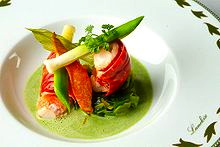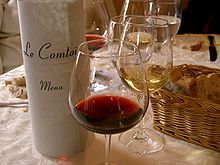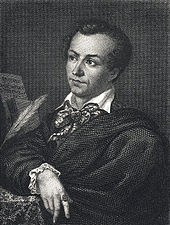French Cusine

DB Bistro’s Chef Stefan Istel shares history with charcuterie
Chef Stefan Istel of DB Bistro in Vancouver shares his onwn hsitory with this charcuterie preparation.
 A nouvelle cuisine presentation French cuisine
A nouvelle cuisine presentation French cuisine
(French: Cuisine française, IPA: [kɥi.zin fʁɑ̃.sɛz]) is a cuisine originating from France. In the Middle Ages, Guillaume Tirel Taillevent, a court chef, wrote Le Viandier, one of the earliest recipe collections of Medieval France. In the 17th century, La Varenne and the notable chef of Napoleon and other dignitaries, Marie-Antoine Carême, moved toward fewer spices and more liberal usage of herbs and creamy ingredients, signaling the beginning of modern cuisine. Cheese and wine are a major part of the cuisine, playing different roles regionally and nationally, with many variations and appellation d’originecontrôlée (AOC) (regulated appellation) laws.
 French Haute cuisine presentation French cuisine was codified in the 20th century by Escoffier to become the modern version of haute cuisine; Escoffier, however, left out much of the regional culinary character to be found in the regions of France. Gastro-tourism and the Guide Michelinhelped to acquaint people with the rich bourgeois and peasant cuisine of the French countryside starting in the 20th century. Gascon cuisine has also had great influence over the cuisine in the southwest of France. Many dishes that were once regional have proliferated in variations across the country. Knowledge of French cooking has contributed significantly to Western cuisines and its criteria are used widely in Western cookery school boards and culinary education. In November 2010, French gastronomy was added by UNESCO to its lists of the world’s “intangible cultural heritage“along with Mexican cuisine.
French Haute cuisine presentation French cuisine was codified in the 20th century by Escoffier to become the modern version of haute cuisine; Escoffier, however, left out much of the regional culinary character to be found in the regions of France. Gastro-tourism and the Guide Michelinhelped to acquaint people with the rich bourgeois and peasant cuisine of the French countryside starting in the 20th century. Gascon cuisine has also had great influence over the cuisine in the southwest of France. Many dishes that were once regional have proliferated in variations across the country. Knowledge of French cooking has contributed significantly to Western cuisines and its criteria are used widely in Western cookery school boards and culinary education. In November 2010, French gastronomy was added by UNESCO to its lists of the world’s “intangible cultural heritage“along with Mexican cuisine.
History
French cuisine has evolved extensively over centuries. The national cuisine started forming in the Middle Ages due to the influence of the work of skilled chefs and various social and political movements. Over the years the styles of French cuisine have been given different names, and have been modified by various master-chefs. During their lifetimes, these chefs have been held in high regard for contributions to the culture of the country. The national cuisine developed primarily in the city of Paris with the chefs to French royalty, but eventually it spread throughout the country and was even exported overseas.
Middle Ages
 John, Duke of Berry enjoying a grand meal. The Duke is sitting with a cardinal at the high table, under a luxurious baldaquin, in front of the fireplace, tended to by several servants, including a carver. On the table to the left of the Duke is a golden salt cellar, ornef, in the shape of a ship; illustration from Très Riches Heures du Duc de Berry, ca. 1410.
John, Duke of Berry enjoying a grand meal. The Duke is sitting with a cardinal at the high table, under a luxurious baldaquin, in front of the fireplace, tended to by several servants, including a carver. On the table to the left of the Duke is a golden salt cellar, ornef, in the shape of a ship; illustration from Très Riches Heures du Duc de Berry, ca. 1410.
In French medieval cuisine, banquets were common among the aristocracy. Multiple courses would be prepared, but served in a style called service en confusion, or all at once. Food was generally eaten by hand, meats being sliced off large pieces held between the thumb and two fingers. The sauces were highly seasoned and thick, and heavily flavored mustards were used. Pies were a common banquet item, with the crust serving primarily as a container, rather than as food itself, and it was not until the very end of the Late Middle Ages that the shortcrust pie was developed. Meals often ended with an issue de table, which later changed into the modern dessert, and typically consisted of dragées (in the Middle Ages, meaning spiced lumps of hardened sugar or honey), aged cheese and spiced wine, such as hypocras. The ingredients of the time varied greatly according to the seasons and the church calendar, and many items were preserved with salt, spices, honey, and other preservatives. Late spring, summer, and autumn afforded abundance, while winter meals were more sparse. Livestock were slaughtered at the beginning of winter. Beef was often salted, while pork was salted and smoked. Bacon and sausages would be smoked in the chimney, while the tongue and hams were brined and dried. Cucumbers were brined as well, while greens would be packed in jars with salt. Fruits, nuts and root vegetables would be boiled in honey for preservation. Whale, dolphin and porpoise were considered fish, so during Lent, the salted meats of these sea mammals were eaten. Artificial freshwater ponds (often called stews) held carp, pike, tench, bream, eel, and other fish. Poultry was kept in special yards, with pigeon and squab being reserved for the elite. Game was highly prized, but very rare, and included venison, wild boar, hare, rabbit, and birds. Kitchen gardens provided herbs, including some, such as tansy, rue,pennyroyal, and hyssop, which are rarely used today. Spices were treasured and very expensive at that time – they included pepper, cinnamon, cloves, nutmeg, and mace. Some spices used then, but no longer today in French cuisine are cubebs, long pepper (both from vines similar to black pepper), grains of paradise, and galengale. Sweet-sour flavors were commonly added to dishes with vinegars and verjus combined with sugar (for the affluent) or honey. A common form of food preparation was to finely cook, pound and strain mixtures into fine pastes and mushes, something believed to be beneficial to make use of nutrients. Visual display was prized. Brilliant colors were obtained by the addition of, for example, juices from spinach and the green part of leeks. Yellow came from saffron or egg yolk, while red came from sunflower, and purple came from Crozophora tinctoria or Heliotropium europaeum. Gold and silver leaf were placed on food surfaces and brushed with egg whites. Elaborate and showy dishes were the result, such as tourte parmerienne which was a pastry dish made to look like a castle with chicken-drumstick turrets coated with gold leaf. One of the grandest showpieces of the time was roast swan or peacock sewn back into its skin with feathers intact, the feet and beak being gilded. Since both birds are stringy, and taste unpleasant, the skin and feathers could be kept and filled with the cooked, minced and seasoned flesh of tastier birds, like goose or chicken. The most well known French chef of the Middle Ages was Guillaume Tirel, also known as Taillevent. Taillevent worked in numerous royal kitchens during the 14th century. His first position was as a kitchen boy in 1326. He was chef to Philip VI, then the Dauphin who was son of John II. The Dauphin became King Charles V of France in 1364, with Taillevent as his chief cook. His career spanned sixty-six years, and upon his death he was buried in grand style between his two wives. His tombstone represents him in armor, holding a shield with three cooking pots, marmites, on it.
Ancien régime
French wines are usually made to accompany French cuisine
During the ancien régime, Paris was the central hub of culture and economic activity, and as such, the most highly skilled culinary craftsmen were to be found there. Markets in Paris such as Les Halles, la Mégisserie, those found along Rue Mouffetard, and similar smaller versions in other cities were very important to the distribution of food. Those that gave French produce its characteristic identity were regulated by the guild system, which developed in the Middle Ages. In Paris, the guilds were regulated by city government as well as by the French crown. A guild restricted those in a given branch of the culinary industry to operate only within that field. There were two basic groups of guilds – first, those that supplied the raw materials; butchers, fishmongers, grain merchants, and gardeners. The second group were those that supplied prepared foods; bakers, pastry cooks, saucemakers, poulterers, and caterers. There were also guilds that offered both raw materials and prepared food, such as the charcutiers and rôtisseurs(purveyors of roasted meat dishes). They would supply cooked meat pies and dishes as well as raw meat and poultry. This caused issues with butchers and poulterers, who sold the same raw materials. The guilds served as a training ground for those within the industry. The degrees of assistant-cook, full-fledged cook and master chef were conferred. Those who reached the level of master chef were of considerable rank in their individual industry, and enjoyed a high level of income as well as economic and job security. At times, those in the royal kitchens did fall under the guild hierarchy, but it was necessary to find them a parallel appointment based on their skills after leaving the service of the royal kitchens. This was not uncommon as the Paris cooks’ guild regulations allowed for this movement. During the 18th and 19th centuries, French cuisine assimilated many new food items from the New World. Although they were slow to be adopted, records of banquets show Catherine de’ Medici serving sixty-six turkeys at one dinner. The dish called cassoulet has its roots in the New World discovery of haricot beans, which are central to the dish’s creation, but had not existed outside of the New World until its exploration by Christopher Columbus.
17th century – early 18th century
Haute cuisine (pronounced: [ot kɥizin], “high cuisine”) has foundations during the 17th century with a chef named La Varenne. As author of works such as Le Cuisinier françois, he is credited with publishing the first true French cookbook. His book includes the earliest known reference to roux using pork fat. The book contained two sections, one for meat days, and one for fasting. His recipes marked a change from the style of cookery known in the Middle Ages, to new techniques aimed at creating somewhat lighter dishes, and more modest presentations of pies as individual pastries and turnovers. La Varenne also published a book on pastry in 1667 entitled Le Parfait confitvrier (republished as Le Confiturier françois) which similarly updated and codified the emerging haute cuisine standards for desserts and pastries. Chef François Massialot wrote Le Cuisinier roïal et bourgeois in 1691, during the reign of Louis XIV. The book contains menus served to the royal courts in 1690. Massialot worked mostly as a freelance cook, and was not employed by any particular household. Massialot and many other royal cooks received special privileges by association with the French royalty. They were not subject to the regulation of the guilds; therefore, they could cater weddings and banquets without restriction. His book is the first to list recipes alphabetically, perhaps a forerunner of the first culinary dictionary. It is in this book that a marinade is first seen in print, with one type for poultry and feathered game, while a second is for fish and shellfish. No quantities are listed in the recipes, which suggests that Massialot was writing for trained cooks. The successive updates of Le Cuisinier roïal et bourgeois include important refinements such as adding a glass of wine to fish stock. Definitions were also added to the 1703 edition. The 1712 edition, retitled Le Nouveau cuisinier royal et bourgeois, was increased to two volumes, and was written in a more elaborate style with extensive explanations of technique. Additional smaller preparations are included in this edition as well, leading to lighter preparations, and adding a third course to the meal. Ragout, a stew still central to French cookery, makes its first appearance as a single dish in this edition as well; prior to that, it was listed as a garnish.
Late 18th century – 19th century
The Revolution was integral to the expansion of French cuisine, because it effectively abolished the guilds. This meant any one chef could now produce and sell any culinary item he wished. Marie-Antoine Carême was born in 1784, five years before the onset of the Revolution. He spent his younger years working at a pâtisserie until being discovered by Charles Maurice de Talleyrand-Périgord, who would later cook for the French emperor Napoleon Bonaparte. Prior to his employment with Talleyrand, Carême had become known for his pièces montèes, which were extravagant constructions of pastry and sugar architecture. More important to Carême’s career was his contribution to the refinement of French cuisine. The basis for his style of cooking came from his sauces, which he named mother sauces. Often referred to as fonds, meaning “foundations”, these base sauces, espagnole, velouté, and béchamel, are still known today. Each of these sauces would be made in large quantities in his kitchen, as they were then capable of forming the basis of multiple derivatives. Carême had over one hundred sauces in his repertoire. In his writings, soufflés appear for the first time. Although many of his preparations today seem extravagant, he simplified and codified an even more complex cuisine that had existed beforehand. Central to his codification of the cuisine were Le Maître d’hôtel français (1822), Le Cuisinier parisien (1828) and L’Art de la cuisine française au dix-neuvième siècle (1833–5).



